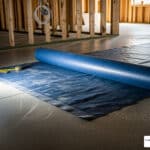Why Fix Basement Crack Issues Before They Become Major Problems
When you need to fix basement crack problems in your home, you’re dealing with more than just a cosmetic issue. Here’s what you need to know right away:
Quick Solutions for Basement Cracks:
- Hairline cracks (less than 1/8″): Monitor for growth, may need professional sealing
- Vertical cracks (1/8″ to 1/4″): Usually settling-related, require polyurethane injection
- Horizontal cracks: Serious structural concern, need immediate professional assessment
- Cracks wider than 1/4″: Call a foundation expert immediately
- Water seeping through cracks: Requires waterproof injection and drainage solutions
That little crack you noticed in your basement wall? It’s trying to tell you something important. We’ve seen it countless times in Baltimore City and Baltimore County homes – what starts as a thin line becomes a water highway during our region’s heavy spring rains.
Foundation cracks happen for several reasons. Your concrete might still be curing and shrinking. Your house could be settling into the soil. Or hydrostatic pressure from all that groundwater might be pushing against your foundation walls.
The truth is simple: ignoring basement cracks costs more money later. Water finds every crack, no matter how small. That water brings humidity, musty smells, and creates the perfect environment for mold growth.
After 70+ years of fixing basements in our area, we’ve learned that homeowners who address cracks early save thousands compared to those who wait. A small crack repair today prevents major structural work tomorrow.
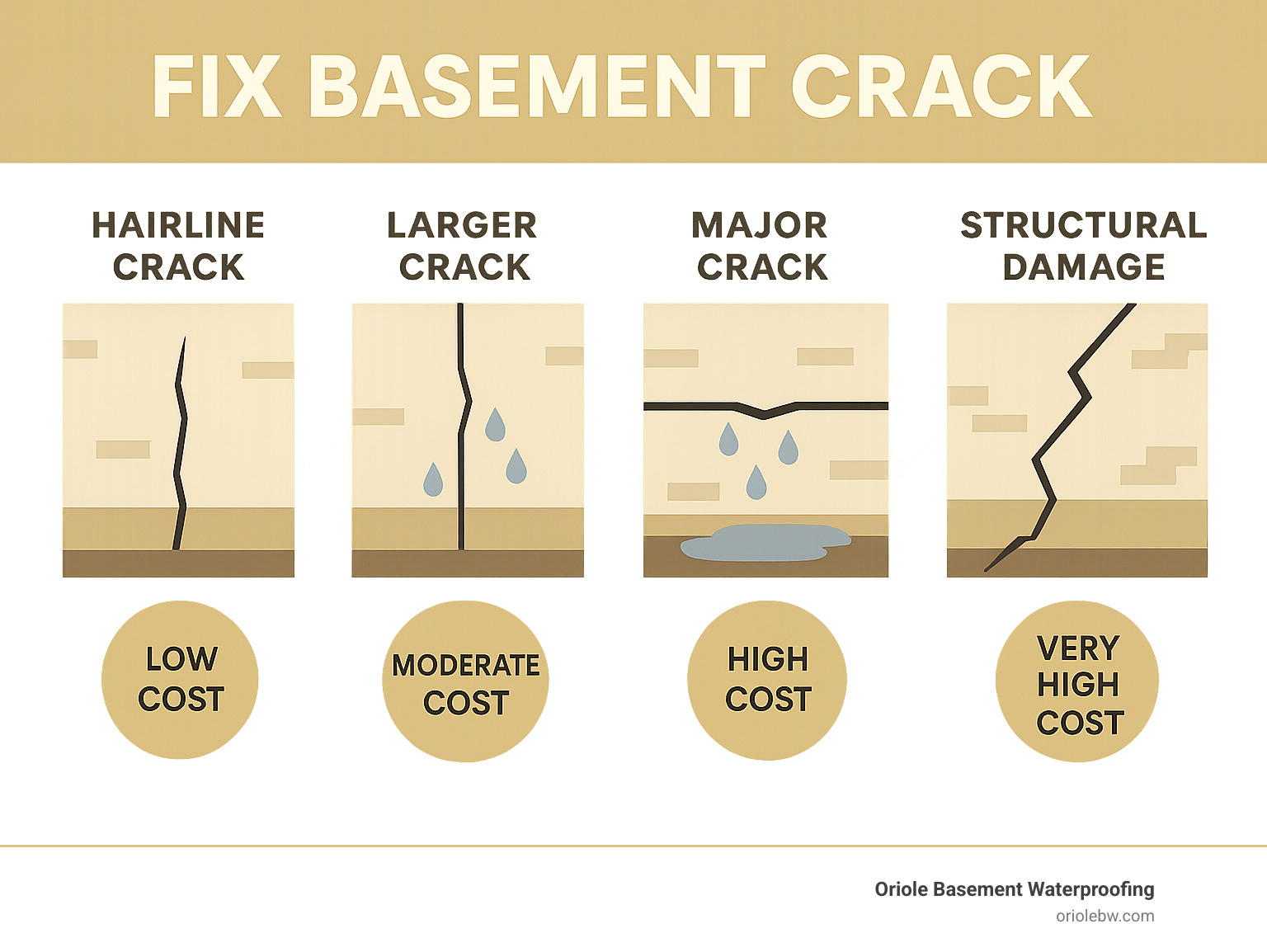
Decoding Basement Cracks: What Are Your Walls Telling You?
That crack in your basement wall isn’t just sitting there quietly – it’s actually trying to have a conversation with you. After seven decades of listening to what local basements have to say, we’ve gotten pretty good at translating crack language.
Here’s the thing: every crack tells a story about what’s happening beneath and around your home. Maybe your concrete is still curing from when it was first poured, slowly shrinking as moisture evaporates. Or perhaps your house is doing what every home does – settling into the soil beneath it, creating stress points along your foundation walls.
But the biggest troublemaker for homeowners in our area? Hydrostatic pressure. When our famous spring rains saturate the clay soil around your foundation, that water-logged earth pushes against your basement walls with incredible force. It’s like having a neighbor who leans too hard against your fence – eventually, something’s got to give.
Soil movement is another major player in the crack game. The clay-heavy soil we have throughout Baltimore City and Baltimore County swells when wet and shrinks when dry. Your foundation walls are basically getting squeezed and released in a constant cycle.
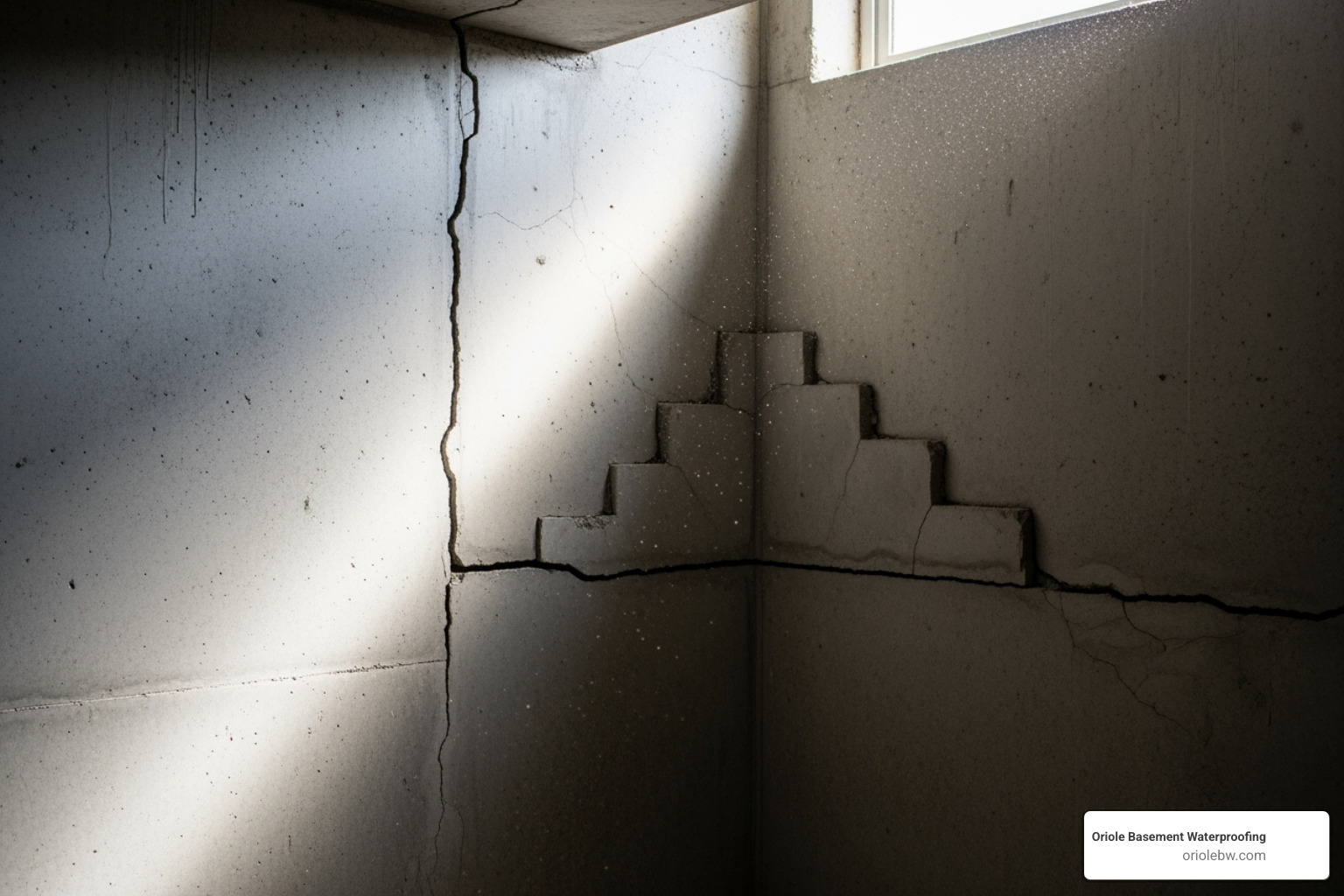
For more detailed information about what causes basement cracks in our area, check out our guide on cracked basements.
Types of Cracks and What They Mean
Learning to read your basement cracks is like learning a new language – once you know what to look for, the messages become crystal clear.
Vertical cracks are the most common visitors to basements in our region. These up-and-down lines usually mean your foundation is settling evenly, or your concrete went through normal shrinkage during curing. While they’re often non-structural, they still create perfect highways for water to fix basement crack problems by allowing moisture into your basement.
Horizontal cracks are the ones that make us sit up and pay attention. When a crack runs sideways across your wall, it’s shouting about serious pressure from outside. This is your foundation’s way of saying “Help! The soil is pushing too hard against me!” These cracks often signal that hydrostatic pressure or expanding clay soil is winning the battle against your basement wall.
Diagonal cracks like to show up near corners or around basement windows. They’re usually telling you about uneven settlement – when one part of your foundation decides to sink faster than another part. Think of it like a house doing a slow-motion split.
Stair-step cracks are particularly chatty in concrete block foundations. They follow the mortar joints in a zigzag pattern, creating what looks like tiny stairs along your wall. This crack pattern is your foundation’s way of reporting differential settlement – basically, “Hey, my left side is sinking faster than my right side!”
Hairline cracks might seem whisper-quiet, but they’re still talking. These thin lines, usually less than 1/8 inch wide, often result from concrete shrinkage. While they’re typically non-structural, they can still invite water problems into your basement.
The width of any crack matters too. Once you’re looking at cracks wider than 1/4 inch, your foundation is no longer whispering – it’s speaking loudly about structural concerns that need immediate professional attention.
Why Basements in Our Area Are Prone to Cracking
Living in this region means dealing with some unique challenges that make our basements particularly talkative when it comes to cracks.
Our local soil conditions are probably the biggest conversation starter. Much of Baltimore City and Baltimore County sits on clay-heavy soil that acts like a sponge – expanding dramatically when wet and shrinking when dry. This constant swelling and contracting puts tremendous stress on foundation walls year after year.
Freeze-thaw cycles add another layer of complexity to the crack conversation. When water seeps into small cracks during our wet seasons, then freezes during winter cold snaps, it expands and makes those cracks larger. Come spring, the ice melts and the process starts all over again.
Heavy rainfall is another major factor in why local basements develop cracks. Our spring and summer downpours can saturate the soil around your foundation quickly, creating that hydrostatic pressure we talked about earlier. It’s like your basement walls are constantly being pushed from the outside.
Finally, many of our aging homes in Baltimore City and Baltimore County have been having these soil and weather conversations for decades. A house built in the 1940s has weathered countless freeze-thaw cycles, heavy rains, and soil movements. Over time, these environmental stresses add up, making older foundations more likely to develop cracks that need professional attention.
The good news? Once you understand what your basement cracks are trying to tell you, you can take action to fix basement crack problems before they become major structural headaches.
When to Worry: Is Your Basement Crack a Minor Flaw or a Major Problem?
Here’s the question that keeps Baltimore homeowners up at night: “Is this crack in my basement wall something I can ignore, or am I looking at a foundation disaster?” After seven decades of crawling through local basements, we’ve learned to read the warning signs. The difference between a structural crack and a non-structural crack can mean the difference between a simple repair and a major foundation overhaul.
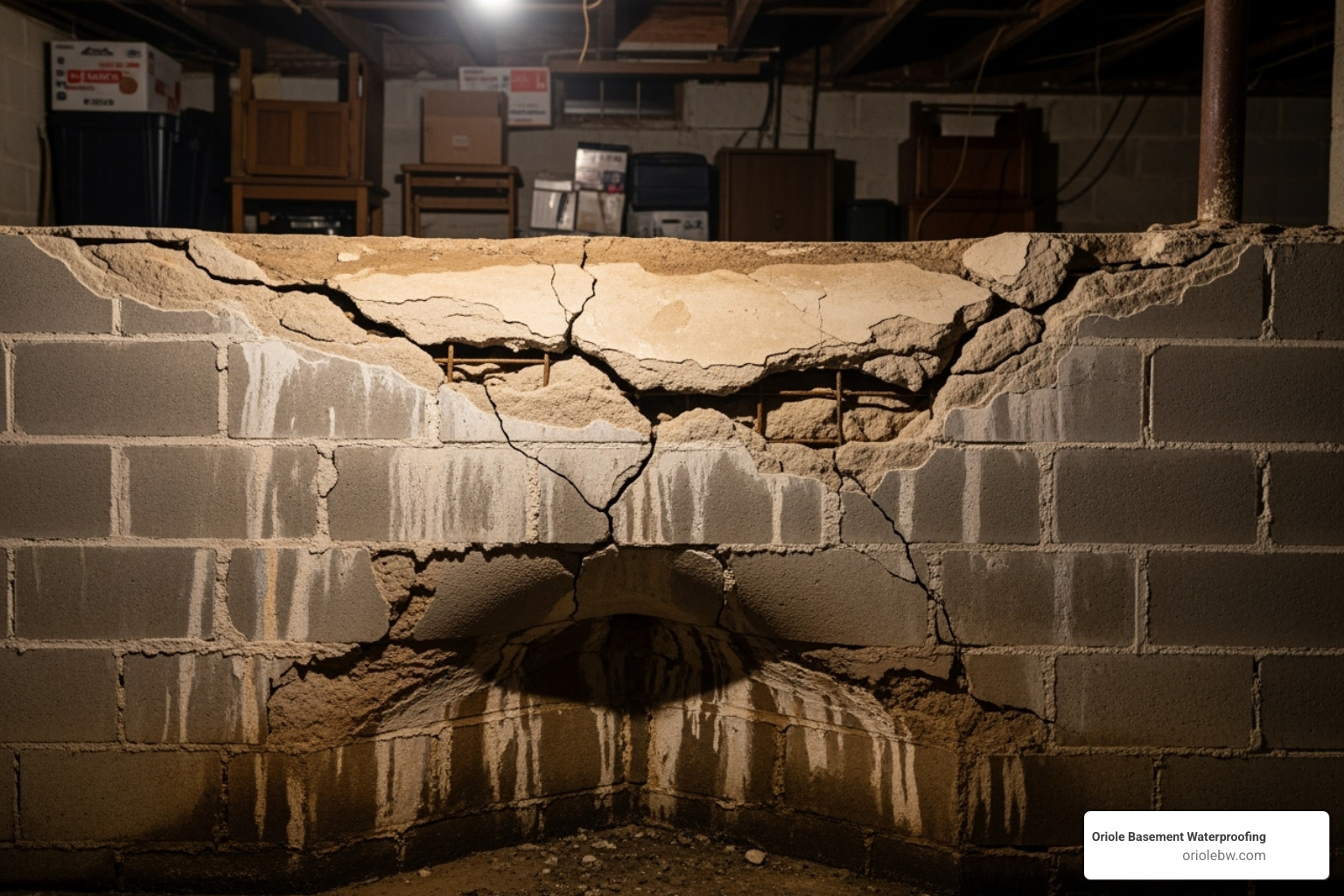
The truth is, some cracks are like wrinkles on an aging face – natural and mostly cosmetic. Others are like chest pains – they demand immediate attention. We’ve seen both in Baltimore City rowhouses and Baltimore County split-levels, and knowing which is which can save you thousands of dollars and countless sleepless nights.
Signs of a Serious Structural Issue
When we walk into a basement and see certain warning signs, we know we’re dealing with more than just settling. These are the red flags that make us reach for our phone to call in a structural engineer.
Crack width over 1/4 inch is where we start paying serious attention. Think of it this way – if you can slide a nickel into the crack, it’s moved beyond the “minor settling” category. We’ve measured cracks in Harford County homes that started as hairlines and grew to half-inch gaps in just one wet season.
Horizontal cracks are the ones that make foundation experts lose sleep. Unlike vertical cracks that often come from normal settling, horizontal cracks scream “pressure problem.” When we see these running sideways across a basement wall, especially with that telltale bowing or bulging, we know the soil outside is literally trying to push the wall into the house. One homeowner in Baltimore County described it perfectly: “It looks like my wall is pregnant.”
Water actively leaking through any crack changes everything. Even a hairline crack becomes urgent when it’s letting our region’s spring rains into your basement. We’ve seen “small” cracks turn finished basements into indoor swimming pools after one heavy storm.
Here’s something most homeowners don’t realize – misaligned walls on either side of a crack tell a story of significant movement. When you run your hand across a crack and feel one side higher than the other, your foundation has shifted enough to create a ledge.
The most telling sign? Sticking doors or windows upstairs. When basement problems start affecting your main floor, your foundation movement has graduated from “basement issue” to “whole house problem.” We’ve helped families who couldn’t figure out why their bedroom door suddenly wouldn’t close properly – until we found the horizontal crack in their basement.
When you see these warning signs, it’s time to learn about basement leak repair solutions to protect your home.
Why Even Small Cracks Need Attention
“It’s just a tiny crack” – we hear this phrase at least once a week. But here’s what we’ve learned from decades of fixing basement crack problems: small cracks are like small holes in a boat. They might not sink you today, but they’re working on it.
Water intrusion is the most immediate concern. That innocent-looking hairline crack becomes a water highway during our region’s notorious downpours. We’ve seen basement floods start with cracks you could barely see without a flashlight.
The moisture and humidity that seep through even tiny cracks create their own problems. Your basement starts feeling like a cave – damp, clammy, and unwelcoming. We’ve worked with families who avoided their basements entirely because of that persistent dampness that started with one small crack.
Musty smells and mold potential follow moisture like shadows. While we focus on stopping the water intrusion that creates these conditions, we often coordinate with mold remediation specialists like Raven Mold when homeowners have both active water problems and existing mold growth.
Don’t forget about pathways for pests. Mice, insects, and other unwanted visitors see cracks as personal invitations into your home. We’ve sealed cracks that were serving as superhighways for everything from ants to field mice.
The biggest reason to address small cracks quickly? They get worse over time. Our region’s freeze-thaw cycles, our clay soil conditions, and seasonal water pressure work together like a team dedicated to making your small crack into a big problem. Fixing basement crack issues early can cost between $1,000-$1,200 from the inside, while waiting until exterior repair is needed can run $3,000-$5,000.
Acting fast when you notice water seeping through a foundation crack isn’t just smart – it’s economical. For more detailed information on professional repair methods, check out this resource on foundation crack repair.
How Professionals Fix Basement Crack Problems
When you find a crack in your basement wall, your first instinct might be to grab some caulk from the hardware store and call it a day. We get it – those DIY crack repair kits look tempting at $75 to $225. But here’s what we’ve learned after 70+ years of fixing local basements: that quick fix usually becomes an expensive lesson.
Professional crack repair typically runs $400 to $500 for a standard repair, or about $100 per linear foot for longer cracks. Yes, it costs more upfront than the DIY route. But when a homeowner in Baltimore County called us last month about a crack they’d “fixed” three times with store-bought epoxy, we understood why they were ready to invest in a permanent solution.
The difference isn’t just about the materials we use – though ours are commercial-grade and come with warranties. It’s about understanding what’s actually causing the crack. We take a holistic approach, examining your drainage, grading, humidity levels, and structural integrity. That way, you’re not chasing the same problem year after year.
Our certified technicians don’t just fix basement crack issues – we solve the underlying problems that created them in the first place. That’s why we can offer a lifetime transferable guarantee on our work.
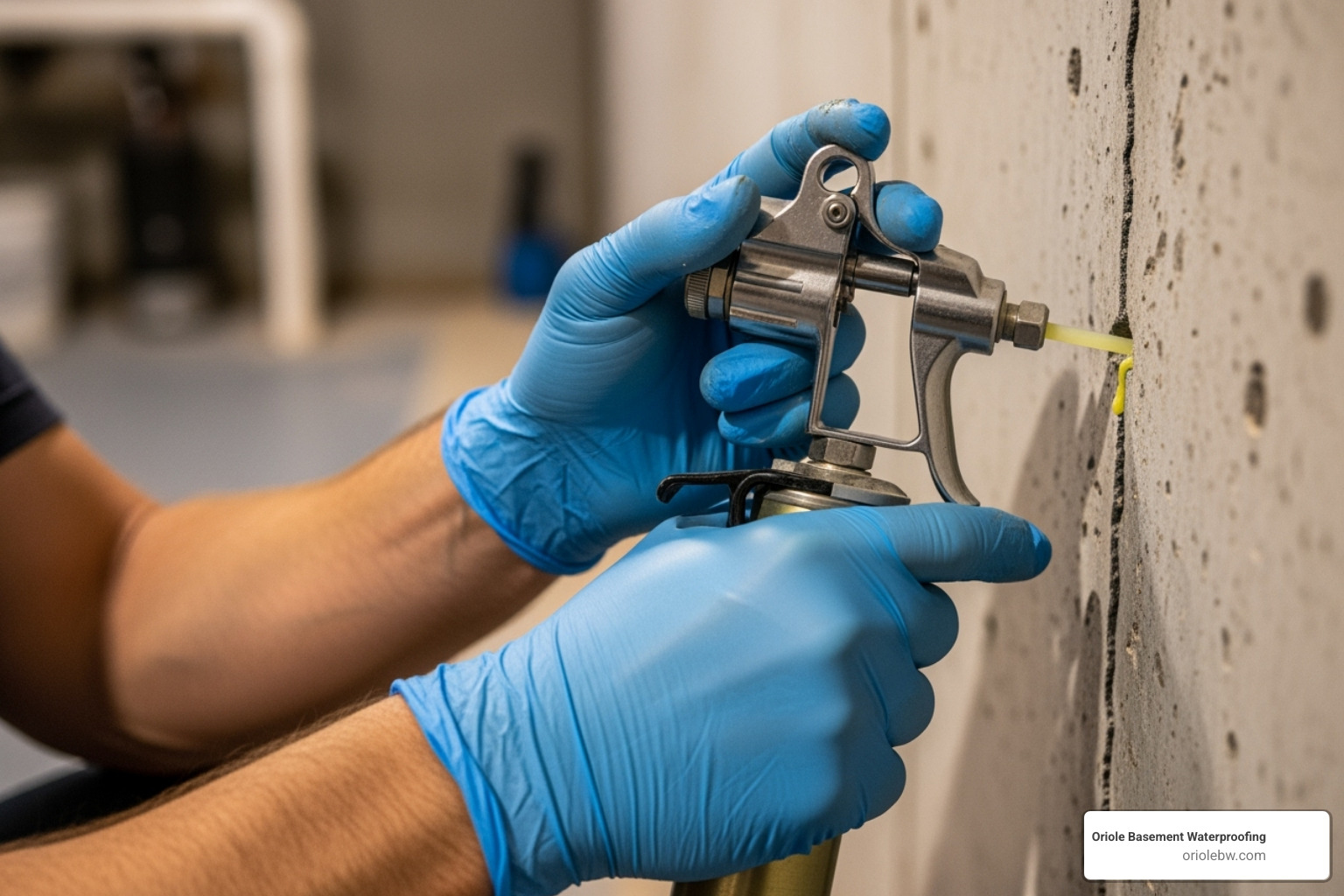
Interior Solutions to fix basement crack issues
Most basement cracks can be effectively repaired from inside your home, which means no digging up your landscaping or disrupting your daily routine.
Polyurethane injection is our go-to solution for stopping water leaks through foundation cracks. This isn’t your typical hardware store sealant. When we inject pharmaceutical-grade polyurethane into a crack, it reacts with any moisture present and expands to fill every crevice. The result is a flexible, watertight seal that moves with your foundation as it naturally shifts with the seasons.
The process itself is methodical. We clean the crack thoroughly, install plastic injection ports along its entire length, and seal the surface with fast-curing material. Then comes the magic – we inject the polyurethane under pressure until it completely fills the crack and creates a permanent barrier against water intrusion.
Epoxy injection serves a different purpose entirely. While polyurethane stops water, epoxy actually bonds the concrete back together, restoring structural integrity. We use this method when the crack indicates foundation movement that needs stabilization. Epoxy cures harder than the original concrete, essentially making the repaired area stronger than it was before.
When we encounter bowing or bulging basement walls – a serious sign of soil pressure – crack injection alone won’t solve the problem. That’s where carbon fiber straps come into play. These straps are incredibly strong (about 10 times stronger than steel) and get applied directly to your basement wall’s interior surface. They reinforce the wall and prevent further inward movement without taking up valuable basement space like traditional steel beams would.
We work with structural engineers on every major foundation repair, ensuring your home’s long-term stability. You can learn more about our comprehensive Foundation Repair process.
Exterior Solutions and Prevention
Sometimes the best way to fix basement crack problems is to address them from the outside – especially when interior access is limited or when we’re dealing with persistent water intrusion.
Exterior waterproofing involves excavating the soil around your foundation’s affected area. Once we expose the wall, we repair the crack and apply a waterproof membrane to the entire exterior surface. This creates a continuous barrier that prevents water from ever reaching your foundation wall again. It’s more involved than interior repairs, with costs typically starting around $5,000, but it’s often the most comprehensive long-term solution.
Proper grading and drainage might not sound exciting, but it’s absolutely critical for preventing future cracks. If the ground around your home slopes toward your foundation instead of away from it, you’re essentially directing hundreds of gallons of water against your basement walls during every rainstorm. We help homeowners correct these grading issues before they become major problems.
Your gutters and downspouts are your first line of defense against basement water issues. We’ve seen too many cases where clogged gutters or downspouts that discharge too close to the foundation create the very problems we’re called in to fix. During our assessment, we make sure your downspouts extend at least six feet away from your home, safely diverting water where it belongs.
For more details on protecting your foundation from the outside, explore our Exterior Foundation Moisture Barrier solutions.
Frequently Asked Questions about Basement Crack Repair
After 70+ years of helping local homeowners, we’ve heard just about every question you can imagine about basement cracks. Whether you’re dealing with a hairline crack or water actively seeping through your foundation wall, these are the concerns that keep Baltimore City and Baltimore County residents up at night.
How much does it cost to fix a basement crack?
Here’s the honest answer: fix basement crack costs vary dramatically based on what’s actually happening with your foundation. We’ve seen homeowners spend $90 on a DIY kit from the hardware store, only to call us six months later when water starts pouring through that same crack during a heavy rainstorm.
Simple crack injection typically runs $400-$500 for accessible cracks, or around $100 per linear foot when you’re dealing with longer cracks or multiple problem areas. But here’s what really determines your investment:
The type of crack makes a huge difference. That hairline crack from normal settling? Much less expensive than a horizontal crack that’s letting water into your basement every time it rains. The repair method matters too – polyurethane injection is straightforward, but if you need carbon fiber straps for a bowing wall, that’s a different conversation entirely.
Accessibility plays a role as well. If your crack is behind a finished wall or in a tight corner, we might need extra time to properly access and repair it.
For major exterior repairs involving excavation and waterproofing membranes, costs start around $5,000. But here’s the thing – we never want to surprise you with costs. That’s why we offer free inspections where we assess your specific situation and provide transparent pricing upfront.
Can a basement crack be fixed permanently?
This is probably the question we hear most often, and the answer is absolutely yes – when it’s done right with professional methods and high-quality materials.
We use proven techniques like polyurethane injection for waterproofing and carbon fiber reinforcement for structural issues. These aren’t temporary patches – they’re engineered solutions designed to last decades. The polyurethane we inject actually reacts with water to expand and create a flexible seal that moves with your foundation. It won’t crack and fail like those DIY kits.
What really sets us apart is our lifetime transferable warranty on all foundation repairs and encapsulation work. We’re so confident in our methods that if you sell your home, the new owners get the same protection. That’s not just a warranty – that’s peace of mind you can actually count on.
We’ve repaired cracks in homes from the 1940s that are still bone dry today. When you combine decades of experience with the right materials and proper installation, permanent really means permanent.
How can I prevent foundation cracks in the first place?
The best crack repair is the one you never have to make. After seeing thousands of Baltimore area basements, we’ve learned that water management is absolutely critical for preventing foundation problems.
Gutter maintenance might seem basic, but clogged gutters dump hundreds of gallons of water right against your foundation during a single storm. We recommend cleaning them twice a year and checking that water flows freely through your downspouts.
Proper yard grading is equally important. Your yard should slope away from your house – at least 2 percent grade for the first six feet. If water pools against your foundation, you’re creating the perfect conditions for hydrostatic pressure and eventual cracking.
Downspout extensions are your foundation’s best friend. Those short little extensions that came with your house? Not nearly long enough. We want to see water discharging at least six feet away from your foundation, preferably into a proper drainage system.
Here’s something most homeowners don’t realize: addressing small cracks promptly actually prevents bigger problems. That hairline crack might not be structural today, but it’s a highway for water. Fix it now, and you won’t be dealing with a major leak later.
For more detailed strategies, check out our 4 Tips for Foundation Waterproofing Ideas. The small steps you take today can save you thousands down the road.
Conclusion: Secure Your Foundation and Your Peace of Mind
That crack in your basement wall isn’t going anywhere on its own. Whether it’s a hairline fissure or a wide gap letting in water during every storm, it’s your foundation’s way of asking for help. We’ve seen too many Baltimore City and Baltimore County homeowners wait until a small problem becomes an expensive emergency.
Here’s what we know after fixing basement crack issues for over 70 years: the homeowners who call us early save thousands compared to those who wait. That tiny crack you’re monitoring? It’s already creating pathways for water, humidity, and eventually mold. Those horizontal cracks showing up after heavy rains? They’re telling you about serious pressure building up against your walls.
The good news is that modern fix basement crack solutions work incredibly well when done right. Our polyurethane injections come with lifetime transferable warranties. Our carbon fiber reinforcement systems are stronger than steel. And our holistic approach means we’re not just patching the symptom – we’re solving the underlying water management issues that caused the crack in the first place.
You don’t have to become an expert on foundation repair or spend your weekends worrying about your basement. That’s what we’re here for. We partner with structural engineers on every major repair. We assess your drainage, grading, and humidity control so you never chase the same problem twice. And our white-glove service means you’ll know exactly what’s happening every step of the way.
Your home is probably your biggest investment. Don’t let foundation problems chip away at its value or your peace of mind. We’ve helped thousands of local families turn their problem basements into spaces they can actually use and enjoy.
Ready to fix basement crack problems for good? Get your free inspection and protect your Baltimore home today!



